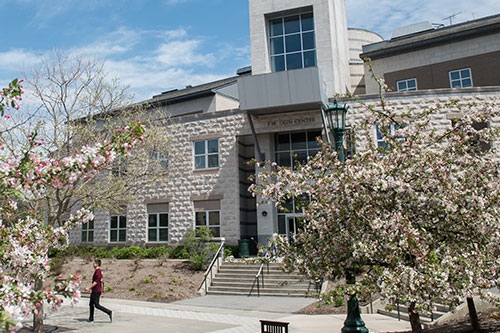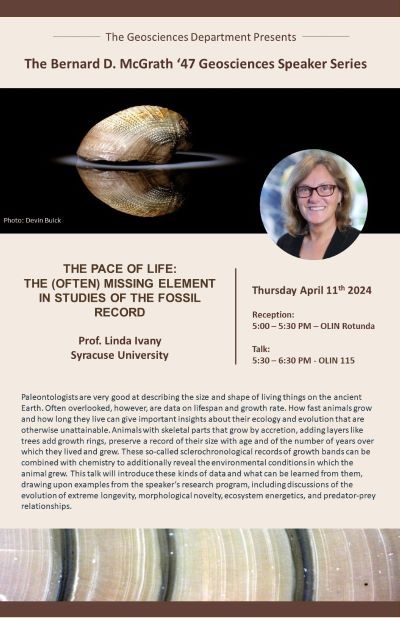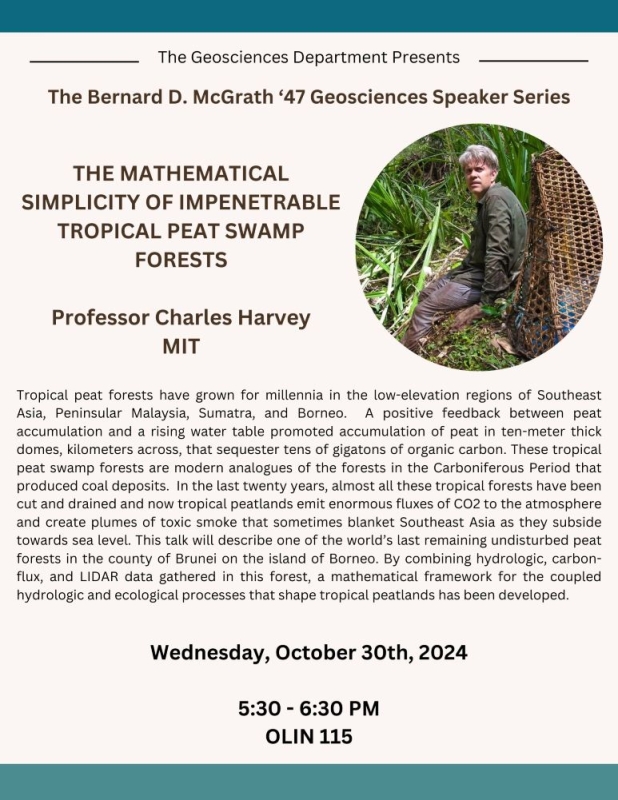Marna McGrath and her four children are proud to establish the Bernard D. McGrath ’47 Geoscience Speaker Series in memory of husband and father, Bernard (Bern) Dennin McGrath ‘47.
Bernard D. McGrath ’47 Geoscience Speaker Series
-
About Bernard D. McGrath '47
Bern completed a degree in geology at Union College that launched his very successful career in the oil and gas industry. After earning his master's degree from Texas A&M, he taught geology briefly at Tarleton State, an A&M college. He was hired by Texaco as a geologist, rising through the ranks during his 30-year tenure to positions in upper management. He later joined Triton Oil & Gas in Dallas, TX and served as the company’s president before fully retiring.
Bern and his older brother Ed McGrath '46 both attended Union, taking leave from their studies to serve in WWII. While Bern was able to return to complete his degree, Ed was tragically killed in the line of duty.
Geology was more than Bern’s career – it included a life-long love of rocks, strata, searching for oil and the land itself. He made great contributions through his work in the industry, and this speaker series will carry on his proud legacy.
Past Speakers
-
Thursday, April 3rd, 2025: Catchment Sensitivities of The West and East Antarctic Ice Sheets to Orbital Forcing During the Mid- To Late Pliocene with Professor Molly Patterson (Joint lecture with IODP Lecturer Series 2024-2025)
CATCHMENT SENSITIVITIES OF THE WEST AND EAST ANTARCTIC ICE SHEETS TO ORBITAL FORCING DURING THE MID- TO LATE PLIOCENE
The Antarctic ice sheet appears as a large, massive homogenous blob on most maps, yet some computer models predict there is considerable variability with respect to how the ice sheet may change under various warming scenarios due to different Earth systems processes. Sediment records recovered from the ice margin during ocean drilling expeditions associated with the International Ocean Discovery Program (IODP) and its predecessor programs can help provide some insight on the causes of Antarctic ice sheet variability. Such insight is fundamental towards understanding some of the sensitivities of how the ice sheet might respond to futureclimate change.
Geochemical records from the deep, which reflect past changes in ice volume and global temperature, demonstrate clear oscillations in ice volume that were paced by astronomical variations. Such astronomical variations involve eccentricity (the shape of Earth’s orbit, ~400 and 100 thousand year cycles, kyr), obliquity (tilt of Earth’s axis, ~41 kyr), and precession (wobble of Earth’s axis, ~20 kyr) cycles. While geological records recovered from the Antarctic margin also demonstrate this, the exact mechanisms for how orbital forcing impacts ice sheet mass balance, including regional sensitivities of ice sheets to marine and terrestrial climate feedbacks, remain elusive. I will present two high-resolution mid-Pliocene to Early Pleistocene (~3.3 to 2.3 Ma) records of iceberg-rafted debris recovered from the West Antarctic Ice Sheet (WAIS) Ross Sea margin and the East Antarctic Ice Sheet (EAIS) Wilkes Land margin collected during IODP Expeditions 374 and 318, respectively. These results suggest that different sectors of marine-based margins of Antarctica’s ice sheets have different sensitivities to various climate and oceanic feedbacks resulting from astronomical variations. Our findings ground-truth computer modelling experiments that highlight large spatial variability in the response of Antarctica’s ice sheet to future warming, and that sensitivities of the ice sheet to atmospheric and marine forcing differ in each catchment.
Dr. Molly Patterson is an Associate Professor in the Department of Earth Sciences at Binghamton University in New York. Much of her career has been driven by a keen interest in better understanding the interactions between the Southern Ocean and the Antarctic Ice Sheet and its downstream influence on the global ocean. This interest began as an undergraduate researcher, when she examined diatoms from Holocene Southern Ocean records while undertaking a B.A. in Geology at Colgate University. Her M.S. thesis at Southern Illinois University of Carbondale focused on examination of foraminifera assemblages from the Antarctic DRILLing Project (ANDRILL) Southern McMurdo Sound Project (AND-2A). Her M.S. experience introduced her to working with large international science teams. She then conducted a Ph.D. at Victoria University of Wellington with researchers in the Antarctic Research Centre in New Zealand. As a Ph.D. student she was first exposed to the ocean drilling program as a part of her thesis work, which involved both legacy core material recovered adjacent to New Zealand, as well as newly recovered material from the Wilkes Land Margin of Antarctica associated with IODP Expedition 318. As a post-doctoral researcher at the University of Massachusetts Amherst, she developed a strong interest in better understanding the connections between Northern Hemisphere and Southern Hemisphere climate systems working with the Lake El’gygytgyn group there. Molly has participated as a shipboard scientist on IODP Exp. 374 to the Ross Sea. She has also served as a panelist on the IODP Science Evaluation Panel (SEP).
-
Thursday, Apri 11th, 2024; The Pace of Life: The (Often) Missing Element in Studies of the Fossil Record with Professor Linda Ivany (Syracuse University)
Previously held onThursday, April 11th, 2024; with Professor Linda Ivany (Syracuse University)
The Pace of Life: The (Often) Missing Element in Studies of the Fossil Record
Paleontologists are very good at describing the size and shape of living things on the ancient Earth. Often overlooked, however, are data on lifespan and growth rate. How fast animals grow and how long they live can give important insights about their ecology and evolution that are otherwise unattainable. Animals with skeletal parts that grow by accretion, adding layers like trees add growth rings, preserve a record of their size with age and of the number of years over
which they lived and grew. These so-called sclerochronological records of growth bands can be combined with chemistry to additionally reveal the environmental conditions in which the animal grew. This talk will introduce these kinds of data and what can be learned from them, drawing upon examples from the speaker’s research program, including discussions of the evolution of extreme longevity, morphological novelty, ecosystem energetics, and predator-prey relationships. -
Wednesday, October 30th, 2024; The Mathematical Simplicity of Impenetrable Tropical Peat Swamp Forests with Professor Charles Harvey (MIT)
Previously held on Wednesday, October 30th, 2024
The Mathematical Simplicity of Impenetrable Tropical Peat Swamp Forests
Tropical peat forests have grown for millennia in the low-elevation regions of Southeast Asia, Peninsular Malaysia, Sumatra, and Borneo. A positive feedback between peat accumulation and a rising water table promoted accumulation of peat in ten-meter thick domes, kilometers across, that sequester tens of gigatons of organic carbon. These tropical peat swamp forests are modern analogues of the forests in the Carboniferous Period that produced coal deposits. In the last twenty years, almost all these tropical forests have been cut and drained and now tropical peatlands emit enormous fluxes of CO2 to the atmosphere and create plumes of toxic smoke that sometimes blanket Southeast Asia as they subside towards sea level. I will describe one of the
world’s last remaining undisturbed peat forests in the county of Brunei on the island of Borneo. By combining hydrologic, carbon-flux, and LIDAR data gathered in this forest, we developed a mathematical framework for the coupled hydrologic and ecological processes that shape tropical peatlands. Model simulations and data agree
that the peat ecosystem has approached an equilibrium over five millennia such that: (1) Carbon emissions and photosynthetic uptake balance throughout the landscape; (2) The water table responds uniformly to rainstorms
across the landscape, and; (3) The topographic curvature of the land surface is described by a spatially uniform Laplacian value that is predicted by rainfall statistics. We test this model by reconstructing paleo-surfaces from peat radiocarbon dates and simulating the development of these surfaces with a numerical model of peat forest dynamics driven by reconstructed paleo-rainfall. We find that peatlands reach their ultimate shape first at the edges of peat domes where they are bounded by rivers, so that the rate of carbon uptake accompanying their growth is proportional to the area of the still-growing dome interior. We use this model to study how tropical peatland carbon storage and fluxes are controlled by changes in climate, sea level, and drainage networks. We
find that fluctuations in net precipitation on timescales from hours to years can reduce long-term peat accumulation. Finally, we apply our mathematical model to propose infrastructure design (canals and roads) that would reduce drainage and hence the rate of peatland loss. -
Wednesday, May 21st, 2025: Growing Under Pressure: Crystallization During Magma Storage and Ascent with Jessica J. Bersson, Buck Postdoctoral Fellow, National Museum of Natural History, Smithsonian Institution
GROWING UNDER PRESSURE: CRYSTALLIZATION DURING MAGMA STORAGE AND ASCENT
Volcanic crystals act as historians of the processes they experienced as the magma they grow from journeys toward the surface. Mineral chemistry reflects the conditions under which they crystallized – pressure (depth), temperature, melt composition, and oxygen availability. While we can’t journey into magma reservoirs to directly measure these conditions, we can recreate them in the lab to understand how specific environments produce specific minerals, compositions, and textures. This allows us to work backward from natural samples to infer the conditions of crystallization. Experiments that simulate rapid decompression provide insight into the smallest crystals in volcanic rocks, which form during the final stages of ascent. This study combines natural samples with high-pressure experiments to quantify crystallization rates and understand how crystals nucleate and grow during magma ascent. These results sharpen reconstructions of pre-eruptive histories and show how crystallization predicts and influences eruptive style.

F.W. Olin Center 310
View in Google Maps




